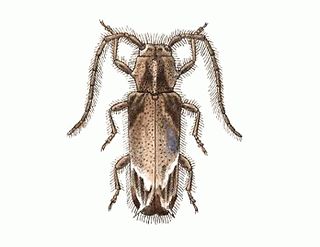Tick-borne diseases, which afflict humans and other animals, are caused by infectious agents transmitted by tick bites. They are caused by infection with a variety of pathogens, including rickettsia and other types of bacteria, viruses, and protozoa. Because individual ticks can harbor more than one disease-causing agent, patients can be infected with more than one pathogen at the same time, compounding the difficulty in diagnosis and treatment. 16 tick-borne diseases of humans are known, of which four have been discovered since 2013.

The Australian king parrot is endemic to eastern Australia ranging from Cooktown in Queensland to Port Campbell in Victoria. Found in humid and heavily forested upland regions of the eastern portion of the continent, including eucalyptus wooded areas in and directly adjacent to subtropical and temperate rainforest. They feed on fruits and seeds gathered from trees or on the ground.
Powassan virus (POWV) is a Flavivirus transmitted by ticks, found in North America and in the Russian Far East. It is named after the town of Powassan, Ontario, where it was identified in a young boy who eventually died from it. It can cause encephalitis, an infection of the brain. No approved vaccine or antiviral drug exists. Prevention of tick bites is the best precaution.

Ixodes scapularis is commonly known as the deer tick or black-legged tick, and in some parts of the US as the bear tick. It is a hard-bodied tick found in the eastern and northern Midwest of the United States as well as in southeastern Canada. It is a vector for several diseases of animals, including humans and is known as the deer tick owing to its habit of parasitizing the white-tailed deer. It is also known to parasitize mice, lizards, migratory birds, etc. especially while the tick is in the larval or nymphal stage.

Desmiphora is a genus of longhorn beetles of the subfamily Lamiinae, containing the following species:
Desmiphora amioca is a species of beetle in the family Cerambycidae. It was described by Galileo and Martins in 1998. It is known from Brazil.
Desmiphora compta is a species of beetle in the family Cerambycidae. It was described by Martins and Galileo in 2005. It is known from Bolivia.

Desmiphora canescens is a species of beetle in the family Cerambycidae. It was described by Henry Walter Bates in 1874. It is known from Colombia, Mexico, and Venezuela.
Desmiphora compacta is a species of beetle in the family Cerambycidae. It was described by Breuning in 1942. It is known from Brazil and Paraguay.
Desmiphora fuscosignata is a species of beetle in the family Cerambycidae. It was described by Breuning in 1942. It is known from Brazil.
Desmiphora obliquelineata is a species of beetle in the family Cerambycidae. It was described by Breuning in 1948. It is known from Brazil.
Desmiphora crocata is a species of beetle in the family Cerambycidae. It was described by Melzer in 1935. It is known from Brazil.
Desmiphora rufocristata is a species of beetle in the family Cerambycidae. It was described by Melzer in 1935. It is known from Brazil.
Desmiphora kawensis is a species of beetle in the family Cerambycidae. It was described by Tavakilian and Néouze in 2004. It is known from French Guiana.
Desmiphora chemsaki is a species of beetle in the family Cerambycidae. It was described by Giesbert in 1998. It is known from Mexico.
Desmiphora digna is a species of beetle in the family Cerambycidae. It was described by Giesbert in 1998. It is known from Panama.
Desmiphora cucullata is a species of beetle in the family Cerambycidae. It was described by Thomson in 1868. It is known from Argentina, Brazil, Paraguay, and Uruguay.
Desmiphora niveocincta is a species of beetle in the family Cerambycidae. It was described by Lane in 1959. It is known from Panama.
Melanoplus scapularis, known generally as the lesser fork-tail grasshopper or scapular spur-throat grasshopper, is a species of spur-throated grasshopper in the family Acrididae. It is found in North America.
Boulenger's least gecko is a species of lizard in the family Sphaerodactylidae. It is found in Ecuador and Colombia.



